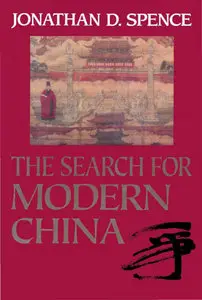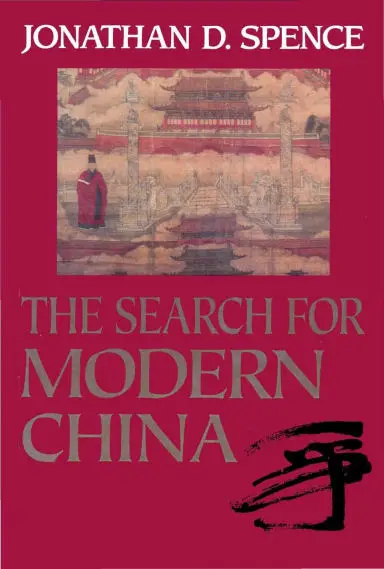Jonathan D. Spence, "The Search for Modern China"
W W Norton & Co | 1990 | ISBN: 0393027082 | siPDF | 876 pages | 26.3 MB
W W Norton & Co | 1990 | ISBN: 0393027082 | siPDF | 876 pages | 26.3 MB
From the Inside Flap
The Search for Modern China is epic history. With unsurpassed learning, imagination, and passion, Jonathan D. Spence tells a story of vast struggle, of exhilarating dreams and crushed lives, and above all of the sheer capacity of the human spirit to endure.
The history of China is as rich and strange as that of any country on earth. Yet for many, China's history remains unknown, or known only through the stylized images that generations in the West have cherished or reviled as truth. With his command of character and event—the product of thirty years of research and reflection in the field—Spence dispels those myths in a powerful narrative.
Over four centuries of Chinese history, from the waning days of the once-glorious Ming dynasty to Deng Xiaoping's bloody suppression of the pro-democracy demonstrations in Tiananmen Square, Spence fashions the astonishing story of the effort to achieve a modern China. Through the ideas and emotions of its reformist Confucian scholars, its poets, novelists, artists, and its visionary students, we see one of the world's oldest cultures struggling to define itself as Chinese and modern. Through the achievements and failures of the great Qing emperors—Kangxi, Yongzheng, and Qianlong—and the dominant figures of the twentieth century—Sun Yat-sen, Chiang Kaishek, Mao Zedong, Zhou Enlai, and Deng Xiaoping—we see an immense nation struggling to establish harmony within and autonomy in the world. And through the daily work of survival and the collective bursts of rebellion and revolution—1644, 1850, 1911, 1949—we see the Chinese people struggling to remake their lives. In the events of spring 1989, Chinas grim cycle of protest and repression continued. One of the oldest human struggles was repeated as its current agony bonded Chinas present to its past.
With 200 black-and-white and 25 full-color illustrations (many published for the first time), and 45 maps.
Product Description
Covering more than four centuries of epic history with unsurpassed learning, imagination, and passion, Spence tells a story of vast struggle, of exhilarating dreams and crushed lives, and above all of the sheer capacity of the human spirit to endure. Professor of history at Yale University and author of numerous works on China, Spence shows the reader a world struggling to remake itself and establish harmony in light of recent events. 136 pages of full-color illustrations and black-and-white photographs
From Publishers Weekly
Spence (The Question of Hu) argues that China's modernization strategies can't work unless the people are allowed to participate in political decision-making. A splendid achievement, this sweeping 1088-page epic chronicle compresses four centuries of political and social change into a sharply observant narrative. Spence offers contemporary perspectives on the British 19th-century drive to get the Chinese masses addicted to opium, Chiang Kai-Shek's secret police apparatus and proto-fascist supporters, Japan's ruthless occupation during WW II, the Mao bloodbath known as the "Cultural Revolution" and the legacy of China's bureaucratic, authoritarian Ming and Qing dynasties.
From School Library Journal
The difficulty of finding a complete, one-volume history of China is no longer a problem with publication of this work, which covers Chinese history from the 16th-century Ming Dynasty to the 1989 "China Spring" demonstrations. The 200+ photographs and illustrations, many in color and previously unpublished, include historical notes that add understanding to the art and the stories illustrated. The text is written in an informative manner that will appeal to students; their lack of knowledge of Chinese history is forstalled by the comprehensive glossary that explains phrases, people, and events.
Contents
List of MapsTags: History, WorldPolitics
List of Tables
List of Illustrations
Preface
Acknowledgments
The Use of Pinyin
I – Conquest And Consolidation
1 The Late Ming
2 The Manchu Conquest
3 Kangxi's Consolidation
4 Yongzheng's Authority
5 Chinese Society and the Reign of Qianlong
6 China and the Eighteenth-Century World
II – Fragmentation and Reform
7 The First Clash with the West
8 The Crisis Within
9 Restoration through Reform
10 New Tensions in the Late Qing
11 The End of the Dynasty
III – Envisioning State and Society
12 The New Republic
13 "A Road is Made"
14 The Clash
15 Experiments in Government
16 The Drift to War
IV – War and Revolution
17 World War II
18 The Fall of the Guomindang State
19 The Birth of the People's Republic
20 Planning the New Society
21 Deepening the Revolution
V – Living in the World
22 Reopening the Doors
23 Redefining Revolution
24 Levels of Power
25 Testing the Limits
Notes and Permissions
Further Readings
Glossary
About the Color Illustrations
Illustration Credits
A Note on the Calligraphy
Index



